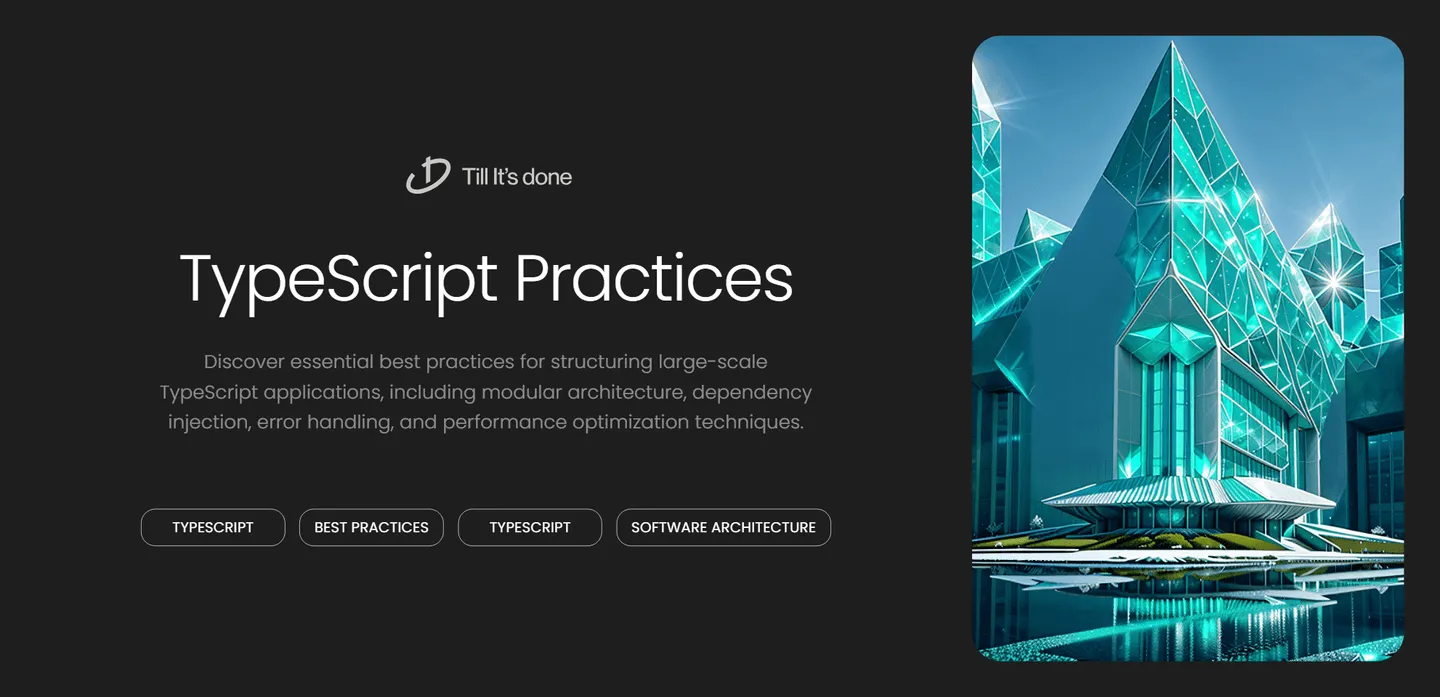- Services
- Case Studies
- Technologies
- NextJs development
- Flutter development
- NodeJs development
- ReactJs development
- About
- Contact
- Tools
- Blogs
- FAQ
Best Practices for TypeScript Applications

Best Practices for Structuring Large TypeScript Applications

As TypeScript applications grow larger, maintaining a clean and scalable codebase becomes increasingly challenging. Through years of experience and countless refactoring sessions, I’ve discovered that proper structure isn’t just about organizing files – it’s about creating a sustainable ecosystem where your code can evolve gracefully.

The Foundation: Project Architecture
The backbone of any well-structured TypeScript application lies in its architecture. Let’s dive into the key principles that can make or break your project’s maintainability.
Module Organization
Think of your application as a well-organized city. Each district (module) serves a specific purpose, and the streets (interfaces) connecting them are carefully planned. Here’s how I approach it:
src/ ├── core/ // Core business logic ├── features/ // Feature-specific modules ├── shared/ // Shared utilities and components ├── infrastructure/ // External service integrations └── types/ // Global type definitionsThe Power of Barrel Files
One practice that’s transformed how I manage imports is using barrel files (index.ts). They act as a single entry point for module exports, making import statements cleaner and more maintainable:
export * from './auth.service';export * from './auth.types';export * from './auth.utils';
Type Safety and Domain Modeling
The real power of TypeScript shines when you leverage its type system effectively. Here are some battle-tested practices:
Strong Domain Types
Instead of using primitive types everywhere, create meaningful domain types that carry business logic:
// Badfunction processUser(name: string, age: number) { ... }
// Goodtype User = { name: string; age: number; role: UserRole;}
function processUser(user: User) { ... }Dependency Injection
Implement a robust dependency injection system to maintain loose coupling between modules:
interface IUserService { getUser(id: string): Promise<User>;}
class UserController { constructor(private userService: IUserService) {}
async handleUserRequest(id: string) { return await this.userService.getUser(id); }}Error Handling and Validation
One aspect that often gets overlooked is consistent error handling. I’ve found that creating a unified approach to errors saves countless hours of debugging:
class ApplicationError extends Error { constructor( public code: string, public message: string, public details?: unknown ) { super(message); }}Performance Considerations
When scaling TypeScript applications, performance becomes crucial. Here are some practices I’ve found invaluable:
- Use lazy loading for modules where possible
- Implement proper memoization for expensive computations
- Keep an eye on bundle size through proper code splitting
- Leverage TypeScript’s const assertions for better compile-time optimizations

Conclusion
Structuring large TypeScript applications is an art that combines technical expertise with architectural vision. By following these practices, you’re not just organizing code – you’re building a foundation that will support your application’s growth for years to come.
 สร้างเว็บไซต์ 1 เว็บ ต้องใช้งบเท่าไหร่? เจาะลึกทุกองค์ประกอบ website development cost อยากสร้างเว็บไซต์แต่ไม่มั่นใจในเรื่องของงบประมาณ อ่านสรุปเจาะลึกตั้งแต่ดีไซน์, ฟังก์ชัน และการดูแล พร้อมตัวอย่างงบจริงจาก Till it’s done ที่แผนชัด งบไม่บานปลายแน่นอน
สร้างเว็บไซต์ 1 เว็บ ต้องใช้งบเท่าไหร่? เจาะลึกทุกองค์ประกอบ website development cost อยากสร้างเว็บไซต์แต่ไม่มั่นใจในเรื่องของงบประมาณ อ่านสรุปเจาะลึกตั้งแต่ดีไซน์, ฟังก์ชัน และการดูแล พร้อมตัวอย่างงบจริงจาก Till it’s done ที่แผนชัด งบไม่บานปลายแน่นอน  Next.js สอน 14 ขั้นตอนเบื้องต้น: สร้างโปรเจกต์แรกใน 30 นาที เริ่มต้นกับ Next.js ใน 14 ขั้นตอนเพียงแค่ 30 นาที พร้อม SSR/SSG และ API Routes ด้วยตัวอย่างโค้ดง่าย ๆ อ่านต่อเพื่อสร้างโปรเจ็กต์แรกได้ทันทีที่นี่
Next.js สอน 14 ขั้นตอนเบื้องต้น: สร้างโปรเจกต์แรกใน 30 นาที เริ่มต้นกับ Next.js ใน 14 ขั้นตอนเพียงแค่ 30 นาที พร้อม SSR/SSG และ API Routes ด้วยตัวอย่างโค้ดง่าย ๆ อ่านต่อเพื่อสร้างโปรเจ็กต์แรกได้ทันทีที่นี่  วิธีสมัคร Apple Developer Account เพื่อนำแอปขึ้น App Store ทีละขั้นตอน อยากปล่อยแอปบน App Store ระดับโลก มาอ่านคู่มือสมัคร Apple Developer Account พร้อมเคล็ดลับ TestFlight และวิธีอัปโหลดที่ง่ายในบทความเดียวนี้ได้เลย
วิธีสมัคร Apple Developer Account เพื่อนำแอปขึ้น App Store ทีละขั้นตอน อยากปล่อยแอปบน App Store ระดับโลก มาอ่านคู่มือสมัคร Apple Developer Account พร้อมเคล็ดลับ TestFlight และวิธีอัปโหลดที่ง่ายในบทความเดียวนี้ได้เลย  TypeScript Interface คืออะไร? อธิบายพร้อมวิธีใช้และข้อแตกต่างจาก Type เรียนรู้วิธีใช้ TypeScript Interface เพื่อสร้างโครงสร้างข้อมูลที่ปลอดภัยและเข้าใจง่าย พร้อมเปรียบเทียบข้อดีข้อแตกต่างกับ Type ที่คุณต้องรู้ ถูกรวมเอาไว้ในบทความนี้แล้ว
TypeScript Interface คืออะไร? อธิบายพร้อมวิธีใช้และข้อแตกต่างจาก Type เรียนรู้วิธีใช้ TypeScript Interface เพื่อสร้างโครงสร้างข้อมูลที่ปลอดภัยและเข้าใจง่าย พร้อมเปรียบเทียบข้อดีข้อแตกต่างกับ Type ที่คุณต้องรู้ ถูกรวมเอาไว้ในบทความนี้แล้ว  Material-UI (MUI) คืออะไร อยากสร้าง UI สวยงามและเป็นมืออาชีพในเวลาอันรวดเร็วใช่ไหม มาทำความรู้จักกับ Material-UI (MUI) ที่ช่วยให้คุณพัฒนาแอปพลิเคชันบน React ได้ง่ายและดูดีในทุกอุปกรณ์
Material-UI (MUI) คืออะไร อยากสร้าง UI สวยงามและเป็นมืออาชีพในเวลาอันรวดเร็วใช่ไหม มาทำความรู้จักกับ Material-UI (MUI) ที่ช่วยให้คุณพัฒนาแอปพลิเคชันบน React ได้ง่ายและดูดีในทุกอุปกรณ์  เปรียบเทียบ 3 วิธีติดตั้ง install node js บน Ubuntu: NVM vs NodeSource vs Official Repo แบบไหนดีที่สุด? เรียนรู้วิธีติดตั้ง Node.js บน Ubuntu ด้วย NVM, NodeSource หรือ Official Repo เลือกวิธีที่เหมาะกับความต้องการของคุณ พร้อมเปรียบเทียบ เพื่อการพัฒนาที่มีประสิทธิภาพ!
เปรียบเทียบ 3 วิธีติดตั้ง install node js บน Ubuntu: NVM vs NodeSource vs Official Repo แบบไหนดีที่สุด? เรียนรู้วิธีติดตั้ง Node.js บน Ubuntu ด้วย NVM, NodeSource หรือ Official Repo เลือกวิธีที่เหมาะกับความต้องการของคุณ พร้อมเปรียบเทียบ เพื่อการพัฒนาที่มีประสิทธิภาพ! Talk with CEO
We'll be right here with you every step of the way.
We'll be here, prepared to commence this promising collaboration.
Whether you're curious about features, warranties, or shopping policies, we provide comprehensive answers to assist you.


